
Concept explainers
Draw the products formed when each compound is treated with
a. b.
b. c.
c. d.
d. 
(a)
Interpretation: The products formed by the treatment of given compound with
Concept introduction: The replacement or substitution of one functional group with another different functional group in any chemical reaction is termed as substitution reaction. The electron deficient chemical species that contains positive charge are known as electrophile. In electrophilic aromatic substitution reaction, electrophile takes the position of hydrogen atom by attacking the electron rich carbon atom of benzene.
Answer to Problem 18.22P
The products formed by the treatment of given compound with
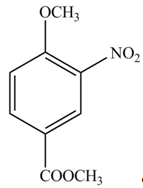
Explanation of Solution
The aromatic compound on reaction with
The structure of given compound shows that benzene ring is substituted by
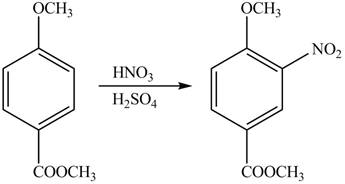
Figure 1
The products formed by the treatment of given compound with
(b)
Interpretation: The products formed by the treatment of given compound with
Concept introduction: The replacement or substitution of one functional group with another different functional group in any chemical reaction is termed as substitution reaction. The electron deficient chemical species that contains positive charge are known as electrophile. In electrophilic aromatic substitution reaction, electrophile takes the position of hydrogen atom by attacking the electron rich carbon atom of benzene.
Answer to Problem 18.22P
The products formed by the treatment of given compound with
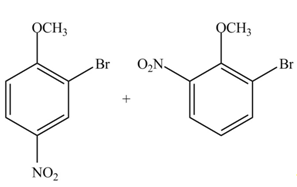
Explanation of Solution
The aromatic compound on reaction with
The structure of given compound shows that benzene ring is substituted by
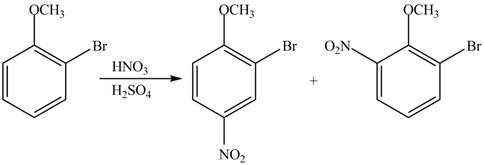
Figure 2
The products formed by the treatment of given compound with
(c)
Interpretation: The products formed by the treatment of given compound with
Concept introduction: The replacement or substitution of one functional group with another different functional group in any chemical reaction is termed as substitution reaction. The electron deficient chemical species that contains positive charge are known as electrophile. In electrophilic aromatic substitution reaction, electrophile takes the position of hydrogen atom by attacking the electron rich carbon atom of benzene.
Answer to Problem 18.22P
The products formed by the treatment of given compound with
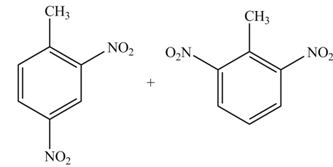
Explanation of Solution
The aromatic compound on reaction with
The structure of given compound shows that benzene ring is substituted by

Figure 3
The products formed by the treatment of given compound with
(d)
Interpretation: The products formed by the treatment of given compound with
Concept introduction: The replacement or substitution of one functional group with another different functional group in any chemical reaction is termed as substitution reaction. The electron deficient chemical species that contains positive charge are known as electrophile. In electrophilic aromatic substitution reaction, electrophile takes the position of hydrogen atom by attacking the electron rich carbon atom of benzene.
Answer to Problem 18.22P
The products formed by the treatment of given compound with
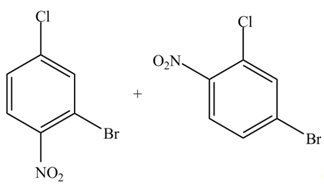
Explanation of Solution
The aromatic compound on reaction with
The structure of given compound shows that benzene ring is substituted by

Figure 4
The products formed by the treatment of given compound with
Want to see more full solutions like this?
Chapter 18 Solutions
Organic Chemistry
- What reagents should be used?arrow_forwardAnswer each question for A and B depicted in the ball-and-stick models.a. What is the IUPAC name for each compound?b. What product is formed when each compound is treated with NaOH?c. Name the products formed in part (b).d. Draw the structure of an isomer that is at least 105 times less acidic than each compound.arrow_forwardDraw the products formed when A or B is treated with each reagent. In some cases, no reaction occurs. [1] C6H5Li (excess); [2] H2Oarrow_forward
- Drawing the Products When Acetylide Anions React with Alkyl Halides Draw the organic products formed in each reaction.arrow_forwardDraw the product formed when each compound is treated with NaNO2 and HCl.arrow_forward(a) Give an acceptable name for compound A. (b) Draw the organic products formed when A is treated with each reagent: [1] H3O+; [2] −OH, H2O; [3] CH3CH2CH2MgBr (excess), then H2O; [4] LiAlH4, then H2O.arrow_forward
 ChemistryChemistryISBN:9781305957404Author:Steven S. Zumdahl, Susan A. Zumdahl, Donald J. DeCostePublisher:Cengage Learning
ChemistryChemistryISBN:9781305957404Author:Steven S. Zumdahl, Susan A. Zumdahl, Donald J. DeCostePublisher:Cengage Learning ChemistryChemistryISBN:9781259911156Author:Raymond Chang Dr., Jason Overby ProfessorPublisher:McGraw-Hill Education
ChemistryChemistryISBN:9781259911156Author:Raymond Chang Dr., Jason Overby ProfessorPublisher:McGraw-Hill Education Principles of Instrumental AnalysisChemistryISBN:9781305577213Author:Douglas A. Skoog, F. James Holler, Stanley R. CrouchPublisher:Cengage Learning
Principles of Instrumental AnalysisChemistryISBN:9781305577213Author:Douglas A. Skoog, F. James Holler, Stanley R. CrouchPublisher:Cengage Learning Organic ChemistryChemistryISBN:9780078021558Author:Janice Gorzynski Smith Dr.Publisher:McGraw-Hill Education
Organic ChemistryChemistryISBN:9780078021558Author:Janice Gorzynski Smith Dr.Publisher:McGraw-Hill Education Chemistry: Principles and ReactionsChemistryISBN:9781305079373Author:William L. Masterton, Cecile N. HurleyPublisher:Cengage Learning
Chemistry: Principles and ReactionsChemistryISBN:9781305079373Author:William L. Masterton, Cecile N. HurleyPublisher:Cengage Learning Elementary Principles of Chemical Processes, Bind...ChemistryISBN:9781118431221Author:Richard M. Felder, Ronald W. Rousseau, Lisa G. BullardPublisher:WILEY
Elementary Principles of Chemical Processes, Bind...ChemistryISBN:9781118431221Author:Richard M. Felder, Ronald W. Rousseau, Lisa G. BullardPublisher:WILEY





